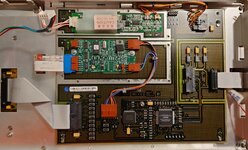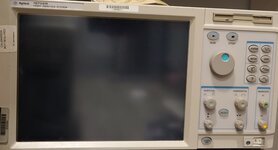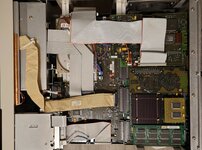Quite some time ago I picked up an HP 16702B logic analyzer frame, and have used it for a variety of projects. But all this time, it has had one very annoying fault: the built-in display was not working. That's why it was priced so low, the used equipment wholesaler thought it was irreparably broken.
Fortunately, the 16702B works with an external display. Plug in a PS/2 keyboard, connect your VGA monitor to it, and hammer the <tab> key repeatedly right after startup until you see the output on your monitor (this takes nearly two minutes by the way). Problem solved.
The LCD failure has been bugging me recently, so naturally I read the service manual and took the thing apart. Service manual only had one basic debug step, where you run a command to set the graphics system to talk to the internal monitor at the proper resolution. Escape key right on startup to break out of normal boot and run the command "COnfiguration MOnitor GRAPHICS(0) 21". And if that results in an LCD which is still dead, replace it and the inverter unit. That command didn't help mine.
I found a new display after some research, and placed an order for it. Installed upon receipt and of course that didn't fix anything. So naturally I decided to poke around a little more.
Picture of the back of the screen assembly is attached. A lot going on here, there's the front panel button board connector (far left), touchscreen ribbon cable (blue connector left of center), LCD inverter (white and pink wires, top left-ish), some sort of inter-board communicator setup, the LCD drive connector (far right) and the unused connector is what goes to the logic analyzer chassis.
That statement about replacing the inverter unit caused some suspicion - why should the inverter need replacing? I've heard that CCFL backlights draw more current as they age, and there's a fuse on the board so naturally I tested it.

It's a strange translucent-yellow-orange color and the fuse filament is clearly visible inside - not visibly damaged. But the fuse measured 70k ohms, clearly too high to let meaningful current through.
Examining the backlight tube on the old monitor shows some charring.

I pulled the fuse off the board and replaced it with what I had on hand: SMD 0805 polyfuse rated for 500mA continuous that will break above 700mA.
Started the machine and waited. And kept waiting (these boot slowly). Eventually the internal display turned on, and it seems totally happy now. No shimmering or blinking. Seems like it's fixed to me.
This means the frame chassis is expecting some sort of signal from the backlight driver that 'everything is ok' before actually enabling display output to the LCD. There was no image there at all before this, I checked with a flashlight. This made me think the LCD had actually died.
For those that encounter this issue in the future, you might be able to get away with replacing the fuse and going with an LED backlight setup. The LCD itself is almost certainly fine. The backlight board fuse failure makes the system think the whole LCD is bad. So give that a shot, LED backlight replacements for these ought to be very doable and then you won't have to find an out-of-production LCD.
Original LCD model number is NL8060AC31-12G, and I replaced it with a NL8060AC31-12 (no G suffix). Looks fine, works fine.
Fortunately, the 16702B works with an external display. Plug in a PS/2 keyboard, connect your VGA monitor to it, and hammer the <tab> key repeatedly right after startup until you see the output on your monitor (this takes nearly two minutes by the way). Problem solved.
The LCD failure has been bugging me recently, so naturally I read the service manual and took the thing apart. Service manual only had one basic debug step, where you run a command to set the graphics system to talk to the internal monitor at the proper resolution. Escape key right on startup to break out of normal boot and run the command "COnfiguration MOnitor GRAPHICS(0) 21". And if that results in an LCD which is still dead, replace it and the inverter unit. That command didn't help mine.
I found a new display after some research, and placed an order for it. Installed upon receipt and of course that didn't fix anything. So naturally I decided to poke around a little more.
Picture of the back of the screen assembly is attached. A lot going on here, there's the front panel button board connector (far left), touchscreen ribbon cable (blue connector left of center), LCD inverter (white and pink wires, top left-ish), some sort of inter-board communicator setup, the LCD drive connector (far right) and the unused connector is what goes to the logic analyzer chassis.
That statement about replacing the inverter unit caused some suspicion - why should the inverter need replacing? I've heard that CCFL backlights draw more current as they age, and there's a fuse on the board so naturally I tested it.
It's a strange translucent-yellow-orange color and the fuse filament is clearly visible inside - not visibly damaged. But the fuse measured 70k ohms, clearly too high to let meaningful current through.
Examining the backlight tube on the old monitor shows some charring.
I pulled the fuse off the board and replaced it with what I had on hand: SMD 0805 polyfuse rated for 500mA continuous that will break above 700mA.
Started the machine and waited. And kept waiting (these boot slowly). Eventually the internal display turned on, and it seems totally happy now. No shimmering or blinking. Seems like it's fixed to me.
This means the frame chassis is expecting some sort of signal from the backlight driver that 'everything is ok' before actually enabling display output to the LCD. There was no image there at all before this, I checked with a flashlight. This made me think the LCD had actually died.
For those that encounter this issue in the future, you might be able to get away with replacing the fuse and going with an LED backlight setup. The LCD itself is almost certainly fine. The backlight board fuse failure makes the system think the whole LCD is bad. So give that a shot, LED backlight replacements for these ought to be very doable and then you won't have to find an out-of-production LCD.
Original LCD model number is NL8060AC31-12G, and I replaced it with a NL8060AC31-12 (no G suffix). Looks fine, works fine.
Attachments
Last edited:



